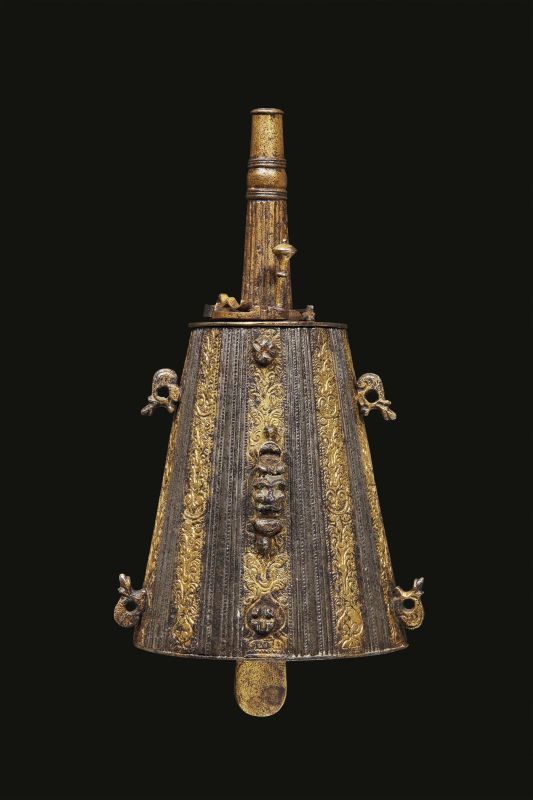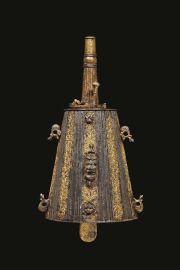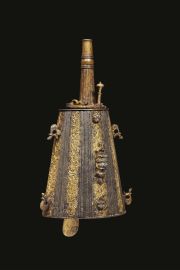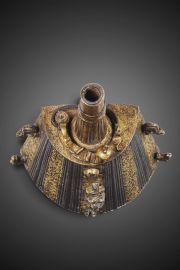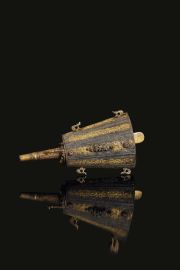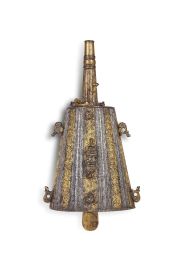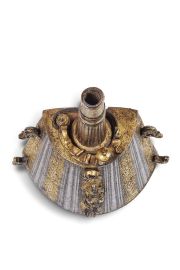FIASCHETTA DA POLVERE, LOMBARDIA, SECONDA METÀ SECOLO XVI
POWDER FLASK, LOMBARDY, SECOND HALF 16TH CENTURY
partially gilded steel; engraved with vertical fluting and plant motifs; raised decorations, 19.6 x 9.8 x 7 cm
Comparative literature
S. Leydi, Mobili milanesi in acciaio e metalli preziosi nell’età del Manierismo, in Fatto in Italia, dal Medioevo al Made in Italy, exhibition catalogue (Turin, Venaria Reale, 19 March – 10 July 2016), Milan 2016, pp. 121-137;
Peter Finer. Provenance, London 2016, pp. 10-13 n. 3
This powder flask is a truncated cone; the lower part of the neck is fluted; the upper part is smooth; the device for opening the spout is adjacent to the convex ring around the neck; the straight tongue on the back with rounded edges is for hooking it to a belt. The whole front is decorated with vertical bands alternating with engraved plant motifs on a gilded ground and smooth or stippled vertical fluting; two pairs of loops on the front for a rope or strap, and in the centre a relief mask. The back is entirely gilded and is decorated with engravings.
Since the Middle Ages, the powder flask, used to load firearms, was an essential part of a soldier’s kit and, of course for hunters. Made of different materials – from horn to bone, from leather to metal – starting in the sixteenth century, elaborately decorated powder flasks began to make their appearance.
Scholars agree that this type of powder flask can be dated to the final years of the sixteenth century. However, we should mention that an interesting recent study published in a 2016 Peter Finer catalogue suggested a dating prior to 1569 for a group of flasks that is similar to ours. The theory is based on the coats of arms (of the Medici and Orsini families) and archive information. In the Medici grand-ducal inventory of 1639 we read: Tre fiasche, che una piccola da polverino, tutte di ferro lavorate a righe, tutte piene, con arme di SAS con lor cordoni a dua” (“Three flasks, there is a small one for powder, all with lines worked in iron all full with arms of SAS [His Serene Highness] with their cords”) (Archivio di Stato di Firenze, Guardaroba Medicea n. 539, for 32a). A flask that is identical to ours is in the Museo Nazionale del Bargello in Florence (n. M1232), while another, which is part of the Odescalchi collection is on display in the Armoury in Palazzo Venezia in Rome (n. 75). Further evidence of the popularity of this type of flask is depicted in a sixteenth-century painting attributed to a follower of David de Coninck (see fig. 1 - David de Coninck (follower) Still Life of Game Birds with a Powder Flask in a Landscape).
The finely engraved flask with its linear but elegant shapes was certainly made to match an equally beautiful firearm for a high-ranking person. Lombardy and the city of Milan, in particular, were famous for their production of extremely highly quality weapons and armour, usually made for nobles and sovereigns throughout Europe. It is a well-known fact that in the second half of the sixteenth century, the “luxury industry” was centred in the city that was still under Spanish domination. It was home to the workshops of famous armourers such as the Negrolis, Pompeo della Cesa and Piccino. Their style and workmanship created the most beautiful armour of the century. Their creative skills transformed mundane objects and weapons into items of exceptional beauty with decorations that included plant motifs, grotesques, and mythological scenes.

